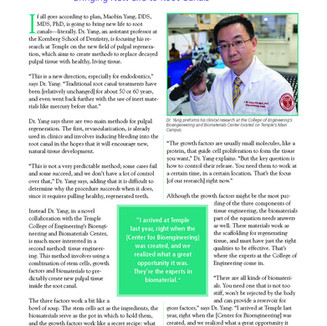Dr. Maobin Yang - Bringing New Life to Root Canals
- maobinyang
- Sep 24, 2019
- 4 min read
Updated: Oct 13, 2019
If all goes according to plan, Maobin Yang, DDS, MDS, PhD, is going to bring new life to root canals—literally. Dr. Yang, an assistant professor at the Kornberg School of Dentistry, is focusing his research at Temple on the new field of pulpal regeneration, which aims to create methods to replace decayed pulpal tissue with healthy, living tissue.
“This is a new direction, especially for endodontics,” says Dr. Yang. “Traditional root canal treatments have been [relatively unchanged] for about 50 or 60 years, and even went back further with the use of inert materials like mercury before that.”
Dr. Yang says there are two main methods for pulpal regeneration. The first, revascularization, is already used in clinics and involves inducing bleeding into the root canal in the hopes that it will encourage new, natural tissue development.
“This is not a very predictable method; some cases fail and some succeed, and we don’t have a lot of control over that,” Dr. Yang says, adding that it is difficult to determine why the procedure succeeds when it does, since it requires pulling healthy, regenerated teeth.
Instead Dr. Yang, in a novel collaboration with the Temple College of Engineering’s Bioengineering and Biomaterials Center, is much more interested in a second method: tissue engineering. This method involves using a combination of stem cells, growth
factors and biomaterials to predictably create new pulpal tissue inside the root canal.
The three factors work a bit like a bowl of soup. The stem cells act as the ingredients, the biomaterials serve as the pot in which to hold them, and the growth factors work like a secret recipe: what temperature to use and how long to boil to achieve the best result.
“The growth factors are usually small molecules, like a protein, that guide cell proliferation to form the tissue you want,” Dr. Yang explains. “But the key question is how to control their release. You need them to work at a certain time, in a certain location. That’s the focus [of our research] right now.”
Although the growth factors might be the most puzzling of the three components of tissue engineering, the biomaterials part of the equation needs answers as well. These materials work as the scaffolding for regenerating tissue, and must have just the right qualities to be effective. That’s where the experts at the College of Engineering come in.
“There are all kinds of biomaterials. You need one that is not too stiff, won’t be rejected by the body and can provide a reservoir for gross factors,” says Dr. Yang. “I arrived at Temple last year, right when the [Center for Bioengineering] was created, and we realized what a great opportunity it was. They’re the experts in biomaterial.”
Dr. Yang works closely with College of Engineering faculty and students, often in the center’s 20,000-square-foot, state-of-the-art lab, to develop appropriate materials. One key factor is the material’s degradation, which Dr. Yang compares to dissolvable stitches.
“You don’t want materials to stay in the human body,” says Dr. Yang. “You have the rate of tissue regeneration, so you have to inversely match that rate with the degradation of the scaffolding.”
None of this would be possible without recent advances in the study of dental stem cells, which lags behind similar fields. While many of the first stem cells were discovered by researchers in the 1960s and ‘70s,
Dr. Yang says the first dental stem cells weren’t discovered until the new millennium. “The first [dental] stem cell was discovered by a Chinese scholar, who was looking at the inside of his daughter’s baby tooth and thinking about what cells are in there,” Dr. Yang says. “Now we know of five kinds. And it turns out these cells are obviously more accessible than from cord blood or bone marrow.”
The possibilities of dental blood cells have fascinated Dr. Yang throughout his studies and career. Born in China, Dr. Yang earned his bachelor’s and master’s degrees there and began clinical work. However, he developed a natural curiosity about how new research might translate into clinical procedures and decided to pursue a PhD in biomedical science at the University of Connecticut.
“I completed my PhD in 2009 but kept thinking about how to apply research to the clinic and continued my residency for another three years,” Dr. Yang says. “I was doing root canal treatments on a daily basis, and every day I’m thinking about how I take out pulp and put in new material, why not come up with a different way?”
Now, using the resources at Temple, Dr. Yang is trying to do exactly that. And the possibilities are promising. “Every year in the U.S., 22 million endodontic procedures are performed, costing about $30 billion,” Dr. Yang says. “And for kids [who have root canals] the root is not formed and will not continue to grow, so conventional treatments leave a very fragile tooth.”
While Dr. Yang’s research is currently fully funded by the university, he says that more money is being set aside by organizations like the American Association of Endodontics, which earmarked $2.5 million for regenerative endodontics in its budget for next year, and the National Institutes of Health.
“This field is going to become more and more competitive because a lot of people think this is the future and will benefit a lot of patients,” Dr. Yang says.
And although he won’t say just how close the research is to being ready for bench and animal studies, Dr. Yang seems to think he has a jump on the field. “This is a hot territory now, but so far we haven’t found another group doing the same thing,” Dr. Yang says. “We believe the things we’re working on are very innovative.”







Comments